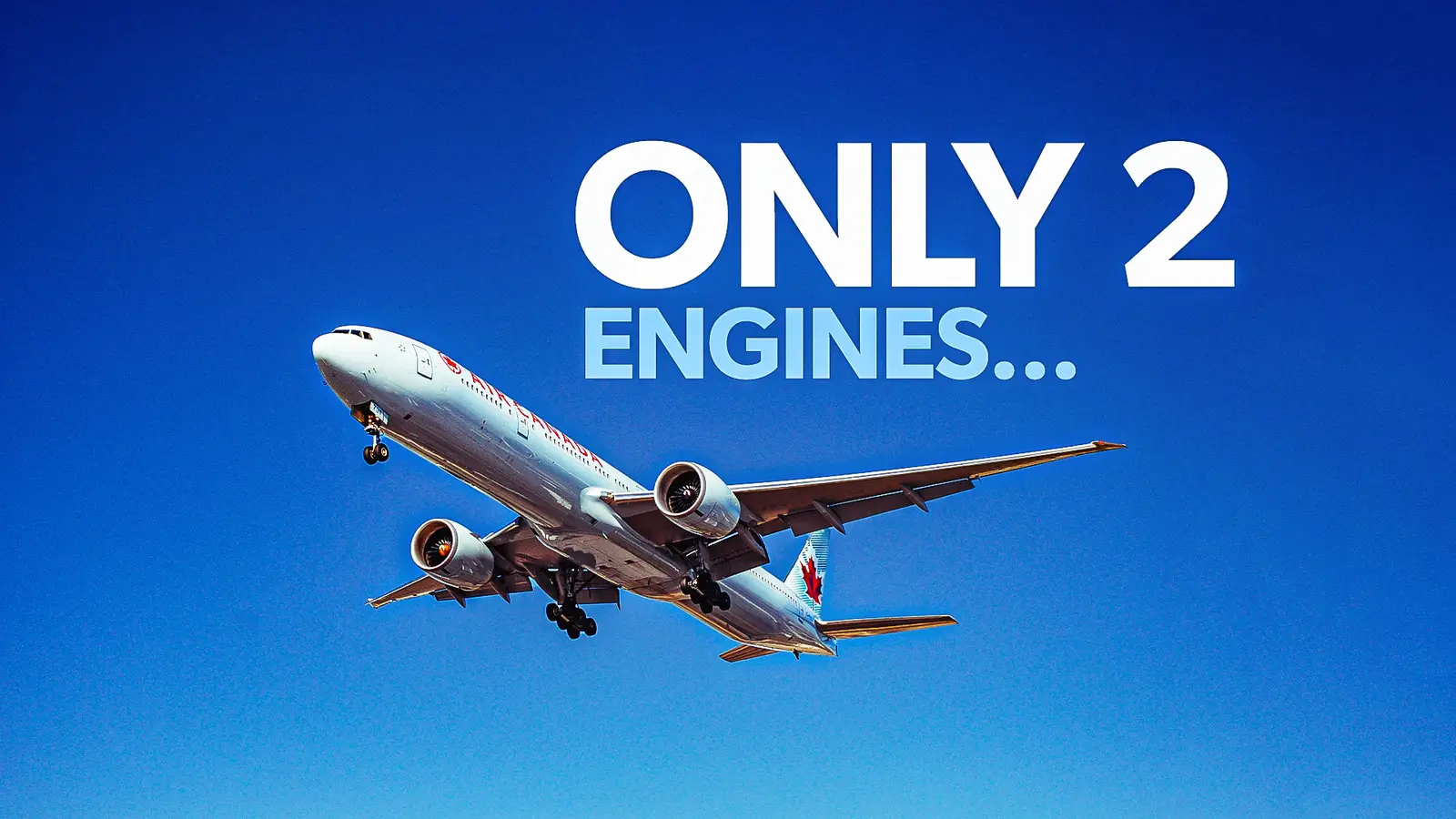
After Boeing produced the twin-engine Boeing 767 and the four-engine Boeing 747, one would have almost expected the Boeing 777 to have four engines. Quadjets and tri-jets had dominated long-haul travel until the late 1980s. So why did Boeing decide to go against the grain and stay with the two-engine model?
The manufacture of the Boeing 777 with two engines was significantly influenced by the success of the Extended-range Twin-engine Operation Performance Standards (ETOPS), which are a safety standard set by ICAO. This permits twin-engined aircraft to operate a route that contains a point further away than one hour flying time with one engine inoperative cruise speed. In the event of a single-engine failure, the aircraft will still be able to reach a diversion airport using the remaining operating engine, although speed and height may be reduced. This applies to flights over water and on long-distance routes previously restricted to three or four-engine aircraft.
The Development Process Of The Boeing 777
During the development of the 777, Boeing made a deliberate decision to be the first aircraft to enter service and fly long-distance routes using ETOPS. Indeed, the 777 was entirely designed to be reliable and safely fly such routes. The 767 had proven to be successful when used for ETOPS flights, demonstrating that twin-engine aircraft could fly long-haul flights.
It was the only other twin-engine aircraft to surpass one million flights by April 1998, and it increased flights across the Atlantic and Pacific regions. The introduction of the Boeing 777 has led to an increase in nonstop flights in the Transpacific region since 1995, with routes increasing by 50%. By May 11, 2007, the Boeing 777 fleet had reached 1,000,000 flights under ETOPS regulations.
The long-haul flights were ruled by tri-jets and quadjets until the late 1980s, when the 60-minute flight time to an alternate airport was waived, and only twinjets were restricted. By the late 1980s, this ruling was relaxed, allowing twinjets to cover longer flights over water.
The Development Of ETOPS Regulations
ETOPS is a global program that enables the aviation industry to operate two-engine jetliners on extended routes, where the aircraft has more than 60 minutes of flight time on a single engine at cruise speed to an alternate airport. It began in 1985, when it was introduced over the North Atlantic and on flights extending to 120 minutes. However, today, long-range aircraft operate under ETOPS rules on nonstop routes all over the world, including routes that link Asia and North America via polar regions, which was implemented in 2000. In 2007, the US Federal Aviation Administration (FAA) implemented ETOPS for multi-engine passenger aircraft, allowing them to fly beyond 180 minutes to an alternate airport, assuming that one engine is inoperable.
In 1985, ETOPS 120 was introduced. The first flight operated was Trans World Airlines (TWA) on February 1, 1985, from Boston to Paris on the Boeing 767-200. Later in 1988, the introduction of ETOPS 180 occurred, covering approximately 95% of the world. The following year, the first ETOPS 180 flight took place, and ETOPS 207 was proposed. The Boeing 777 was the first aircraft to be rated with the ETOPS 180. Regulatory authorities, such as the JAA (Joint Aviation Authorities), adopted the rules within Europe. In the 1990s, the Boeing 777 was rated ETOPS 120 within Europe and, after one year with no issues, moved to ETOPS 180. The FAA allowed ETOPS 180 to be extended within the aircraft’s design limits in 2007. The following year, ETOPS 240 and beyond was permitted. The authorities only grant permission to airlines of two-engine airplanes between specific city pairs. They must have operated ETOPS 180 for two years and one year at ETOPS 240 without any issues.
The benefits of the ETOPS program
Twin jets are known to be economical and efficient.
Increased passenger satisfaction, routes are more direct and convenient.
Simplified long-haul operations.
Operational flexibility.
Reduced economic risk.
In 2011, the FAA approved ETOPS 330 for the Boeing 777 with GE engines. On May 28, 2014,the Boeing 787 received ETOPS 330 certification, and LAN Airlines (now known as LATAM Airlines) was able to move from the Airbus A340 to the Boeing 787 for its Santiago-Auckland-Sydney route a year later. On December 1, 2015, the first ETOPS 330 flight took place on the Boeing 777-200ER, allowing Air New Zealand to fly from Auckland to Buenos Aires. The Airbus 350 XWB was permitted ETOPS 180 on entry into service in Europe and North America. Later, within Europe, this was changed to ETOPS 370, which covers 99.7% of the world’s surface, allowing nonstop flights anywhere except the South Pole. ETOPS 330 approval was given to the Boeing 747-8 Intercontinental in 2015.
The Introduction Of The Boeing 777
The Boeing 777 entered service commercially on June 7, 1995, and the first flight was a transatlantic ETOPS flight operated by United Airlines. As of 2007, the 777 had accumulated more than 14 million ETOPS flight hours. In February 2007, the US FAA updated ETOPS rules and best practices, extending ETOPS to three and four-engine aircraft. This allowed approved twinjets to fly optimal routes between almost any two cities worldwide. Furthermore, it was Boeing’s objective to certify some 777s and 787s, allowing for 330 minutes ETOPS.
The Boeing 777 has been successful for over three decades, with good reason. The 777 family is popular among airlines and passengers due to its fuel efficiency, reliable engines, low operating costs, and spacious cabin. The aircraft is popular in the 300 to 400-seat market and became the world’s largest twinjet. It bridged the gap between the 767 and the 747 when it was launched in October 1990, with the first order from United Airlines. Since the Boeing 777 was introduced, longer-range models have been manufactured, as well as freight variants (777F).
Variants include:
Boeing 777-200
Boeing 777-200ER (Extended Range)
Boeing 777-200LR (Long Range)
Boeing 777-300
Boeing 777-300ER
Boeing 777X
Boeing recognized that point-to-point aircraft would meet market demand, and that twin-engined aircraft like the 777 would be much more fuel-efficient, have lower operating costs as well as be less expensive to manufacture and maintain. Advanced engine technology allowed for two engines to do the work of four engines and improved reliability, safety margins and performance, while ensuring safety overall.
How The Boeing 777 Fleet Impacted The Airline World
The Boeing 777-200LR was specifically designed for long-haul flights, such as Los Angeles to Singapore. The aircraft holds the record for the longest nonstop flight of a commercial airliner from Seattle to Kuala Lumpur, a total of 12,455 miles (20,044 kilometers). The best-selling Boeing variant is the 777-300ER. A total of 831 were built, of which most are still in service.
Over 2,800 Boeing 777s have been ordered and are flown by over 70 operators worldwide, including United Airlines, American Airlines, Qatar Airways, and British Airways. By mid-2025, the Boeing 777 fleet had over 1,200 aircraft in active service, according to data at ch-aviation. Emirates is the largest operator of the 777, with 129 currently in service (777-200LR and 777-300ER) and has 205 new generation Boeing 777 on order, while FedEx has the largest cargo fleet. Interestingly, Emirates is Boeing’s only customer to have operated every variant of the Boeing 777 that has been built.
Aircraft Specifications B777-300ER
Source: Emirates
The third generation of the 777, the Boeing 777X, has two variants, the 777-8 and 777-9, and is expected to start deliveries between 2027 and 2030. As of August 2025, the Boeing 777X had a total of 565 orders from 12 customers, including Emirates, Cathay Pacific, and Qatar Airways. The first delivery was expected in 2026 to launch customer Lufthansa, but the program has faced significant delays. Although the Boeing 777X was introduced in 2013 and deliveries were scheduled for 2020, one of the aircraft suffered an ‘uncommanded pitch event’ and FAA certification is still behind schedule, as reported by Bloomberg.
The Demise Of The Quadjet
Quadjet aircraft have come and gone over the years, from the de Havilland Comet in the 1950s, and later the Boeing 707 in 1958, and the Douglas DC-8 in the 1960s. In the 1970s and 80s, the Boeing 747 was introduced, as well as tri-jets like the Douglas DC-10 and Lockheed L-1011 Tristar. The 1990s and 2000s saw the rise of the Airbus A340 on long-haul routes, often in conjunction with the Boeing 747. It was very much a time of ‘the more engines the better’, and it was believed that they were safer on long-haul routes.
Twinjets emerged later into the long-haul market with the Boeing 777 and the A330, and these in turn eventually phased out the four-engine jets. The 777 and the new 777X outsold the Airbus 340; 2,300 were on order compared to just 380 Airbus 340s before it ceased production in 2011. The largest commercial aircraft in the world, the Boeing 747, and the later Airbus A380, ceased production in recent years.
The new generation Ultra-Long-Range widebody twin-engine Boeing 787, the A350, and the Boeing 777X will rule the skies and will be the future of long-haul travel. They have all been designed with advanced aerodynamics, built with lightweight materials, and feature new-generation engines for better efficiency and performance. They can also use Sustainable Aviation Fuel (SAF), which reduces fuel burn and carbon emissions as well as lowers noise levels, compared to older aircraft.
In Conclusion
The success of the Boeing 777 stemmed from its far superior fuel efficiency and performance compared to four-engine jets. Engine reliability had improved, and engine technology had advanced to improve efficiency and lower maintenance costs. The ETOPS certification ensured safe and viable options for long-haul flights, and the continued extension of ETOPS regulations has secured the twinjet’s role on long-haul routes.
Although the A380 and the Boeing 747 are iconic aircraft, they are not as cost-efficient per seat as the new-generation aircraft. Emirates, Lufthansa, Korean Air, and Singapore Airlines, to name a few, continue to use the A380 on high-density long-haul routes. Primarily, the 747 is used for cargo, although Air China, Lufthansa, and Rossiya also still use them as passenger aircraft.
Boeing’s decision to develop the 777 with two engines instead of four was a prudent one and well-aligned with the ETOPS program. This, in turn, changed the future of aircraft manufacture from double-decker four-engine aircraft to airlines choosing more fuel-efficient two-engine aircraft that are ultra-long-range. In these days of environmental awareness and sustainability, the new Boeing 777X and 787 will undoubtedly follow the original 777s climb to success, as well as redefine the way we travel by air.



